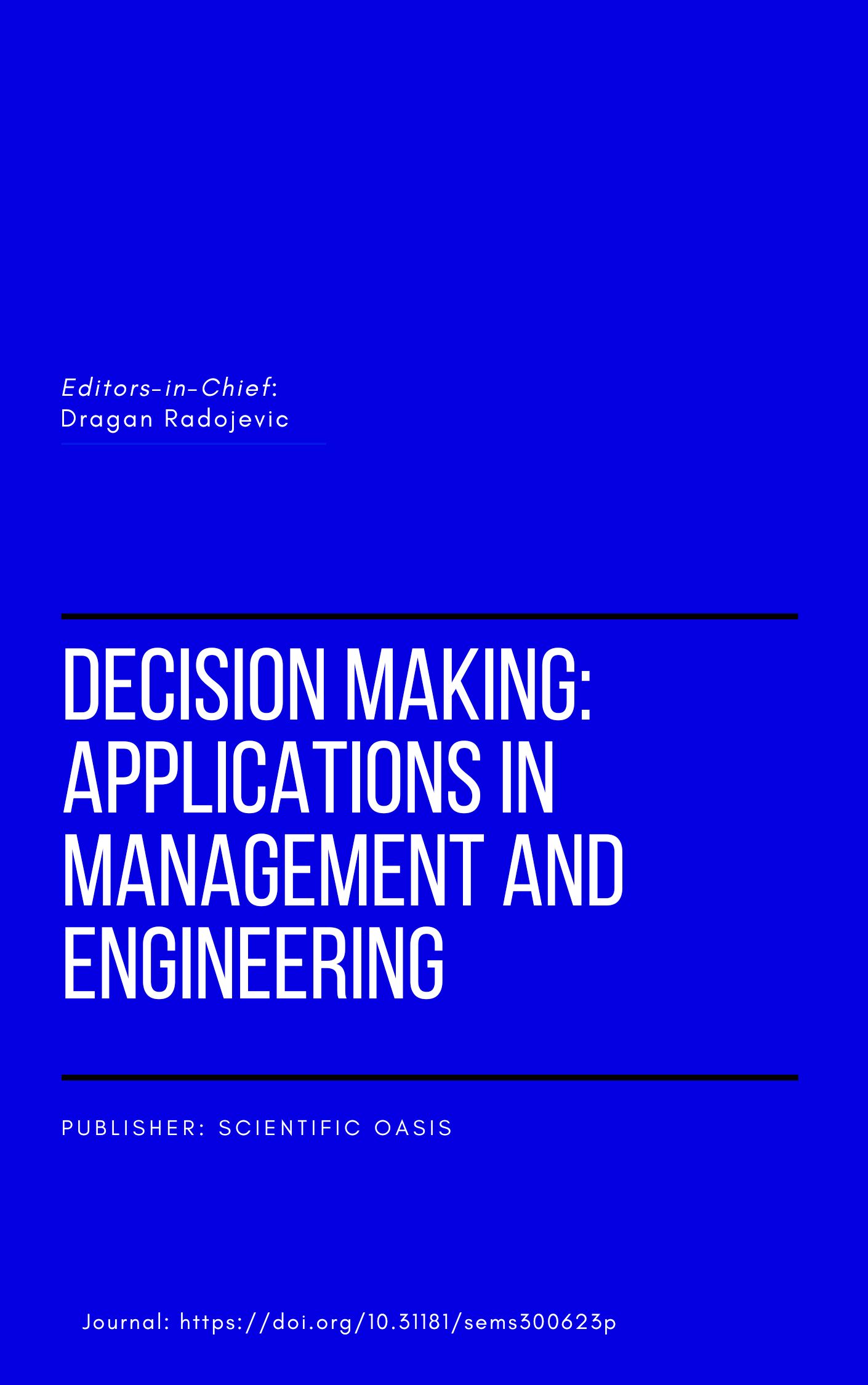Artificial Intelligence-Enabled Decision Making in Social Media Adoption for Sustainable Digital Business in Thai SMEs
DOI:
https://doi.org/10.31181/dmame8120251366Keywords:
Social Media, Artificial Intelligence, Entrepreneurial Orientation, Sustainability, Competitive Advantage, SMEs, Rough Set e-Delphi, SEMAbstract
This study develops and validates a structural equation modeling (SEM) to examine social media adoption by SMEs and its impact on sustainability. It aims to identify key factors influencing SMEs sustainability in the digital context and explore their interrelationships. This study employed a mixed-methods approach. In the qualitative phase, the Rough Set e-Delphi technique was utilised to collect insights from experts and refine the research constructs through three rounds of online questionnaires, involving 20 experts. The quantitative phase involved a survey of 776 executives from Thai SMEs, which served as the primary data collection method. The study results indicate that social media adoption is positively influenced by four factors: perceived usefulness, perceived ease of use, compatibility, and business orientation. The implementation of social media networks has a positive impact, enhancing both performance metrics and competitive advantages for SMEs. This research confirms that the sustainable performance of SMEs significantly contributes to sustainability across their business processes. The findings demonstrate that social media serves as a powerful tool for improving SMEs operations, while fostering competitive advantages that support sustainability. This study demonstrates that entrepreneurial orientation, in conjunction with technology acceptance, facilitates social media adoption. It offers practical implications for artificial intelligence engineering by exploring how AI systems, with digital analytical capabilities, automated functions, and predictive modelling, can improve operational decision-making, supply chain management, and overall performance in SMEs. The insights gained can be utilised by SMEs owners, policymakers, and researchers to enhance the use of social media through AI-driven strategies, promoting sustainable SME growth in emerging economies.
Downloads
References
[1] Malesev, S., & Cherry, M. (2021). Digital and social media marketing-growing market share for construction smes. Construction Economics and Building, 21(1), 65-82. https://doi.org/10.5130/AJCEB.v21i1.7521
[2] Oyewobi, L. O., Adedayo, O. F., Olorunyomi, S. O., & Jimoh, R. (2021). Social media adoption and business performance: the mediating role of organizational learning capability (OLC). Journal of Facilities Management, 19(4), 413-436. https://doi.org/10.1108/JFM-12-2020-0099
[3] Neumeyer, X., Santos, S. C., & Morris, M. H. (2021). Overcoming barriers to technology adoption when fostering entrepreneurship among the poor: The role of technology and digital literacy. IEEE Transactions on Engineering Management, 68(6), 1605-1618. https://doi.org/10.1109/TEM.2020.2989740
[4] Davis, F. D. (1989). Perceived usefulness, perceived ease of use, and user acceptance of information technology. MIS Quarterly: Management Information Systems, 13(3), 319-339. https://doi.org/10.2307/249008
[5] Ndubisi, N. O., & Agarwal, J. (2014). Quality performance of SMEs in a developing economy: Direct and indirect effects of service innovation and entrepreneurial orientation. Journal of Business and Industrial Marketing, 29(6), 454-468. https://doi.org/10.1108/JBIM-07-2013-0146
[6] Jöreskog, K. G. (1970). A general method for analysis of covariance structures. Biometrika, 57(2), 239-251. https://doi.org/10.1093/biomet/57.2.239
[7] Korcsmáros, E., & Csinger, B. (2022). Sustainable Competitiveness in the Case of SMEs—Opportunities Provided by Social Media in an International Comparison. Sustainability (Switzerland), 14(19), 12505. https://doi.org/10.3390/su141912505
[8] Pollák, F., & Markovič, P. (2021). Economic activity as a determinant for customer adoption of social media marketing. Sustainability (Switzerland), 13(7), 3999. https://doi.org/10.3390/su13073999
[9] Barnes, S. J., & Mattsson, J. (2017). Understanding collaborative consumption: Test of a theoretical model. Technological Forecasting and Social Change, 118, 281-292. https://doi.org/10.1016/j.techfore.2017.02.029
[10] Venkatesh, V., & Davis, F. D. (2000). Theoretical extension of the Technology Acceptance Model: Four longitudinal field studies. Management Science, 46(2), 186-204. https://doi.org/10.1287/mnsc.46.2.186.11926
[11] Böhme, R., Christin, N., Edelman, B., & Moore, T. (2015). Bitcoin: Economics, technology, and governance. Journal of Economic Perspectives, 29(2), 213-238. https://doi.org/10.1257/jep.29.2.213
[12] Alshatter, Z., & Al Mubarak, M. (2024). From Green Tech to Digital Tech: Leveraging Digital Solutions for Sustainable Development (SD) in B2B Markets. In S. Seifi & D. Crowther (Eds.), (Vol. Part F3444, pp. 151-171). Springer. https://doi.org/10.1007/978-981-97-4742-9_7
[13] Raihan, A. (2024). A review of the potential opportunities and challenges of the digital economy for sustainability. Innovation and Green Development, 3(4), 100174. https://doi.org/10.1016/j.igd.2024.100174
[14] Chairaksa, N., & Pankham, S. (2023). Modern Entrepreneur for the Success of Online Businesses for Small and Medium Enterprise in Thailand. TEM Journal, 12(2), 956-966. https://doi.org/10.18421/TEM122-42
[15] Karahanna, E., & Straub, D. W. (1999). The psychological origins of perceived usefulness and ease-of-use. Information and Management, 35(4), 237-250. https://doi.org/10.1016/S0378-7206(98)00096-2
[16] Ahmad, S. Z., Abu Bakar, A. R., & Ahmad, N. (2019). Social media adoption and its impact on firm performance: the case of the UAE. International Journal of Entrepreneurial Behaviour and Research, 25(1), 84-111. https://doi.org/10.1108/IJEBR-08-2017-0299
[17] Narwane, V. S., Raut, R. D., Gardas, B. B., Narkhede, B. E., & Awasthi, A. (2022). Examining smart manufacturing challenges in the context of micro, small and medium enterprises. International Journal of Computer Integrated Manufacturing, 35(12), 1395-1412. https://doi.org/10.1080/0951192X.2022.2078508
[18] Adams, D. A., Nelson, R. R., & Todd, P. A. (1992). Perceived usefulness, ease of use, and usage of information technology: A replication. MIS Quarterly: Management Information Systems, 16(2), 227-247. https://doi.org/10.2307/249577
[19] Saadé, R. G. (2007). Dimensions of Perceived Usefulness: Toward Enhanced Assessment. Decision Sciences Journal of Innovative Education, 5(2), 289-310. https://doi.org/10.1111/j.1540-4609.2007.00142.x
[20] Capuano, N., Gaeta, M., Ritrovato, P., & Salerno, S. (2008). How to integrate technology-enhanced learning with business process management. Journal of Knowledge Management, 12(6), 56-71. https://doi.org/10.1108/13673270810913621
[21] Rattanapongpinyo, T. (2016). Business Performance Success by Local Thai Firms Applying Innovation Management and Social Media. Journal Humanities and Social Sciences, 36(3), 113-125. https://so06.tci-thaijo.org/index.php/utccjournalhs/article/view/187808
[22] Ramdani, B., Kawalek, P., & Lorenzo, O. (2009). Predicting SMEs' adoption of enterprise systems. Journal of Enterprise Information Management, 22(1/2), 10-24. https://doi.org/10.1108/17410390910922796
[23] Ramiller, N. C. (1994). Perceived compatibility of information technology innovations among secondary adopters: Toward a reassessment. Journal of Engineering and Technology Management, 11(1), 1-23. https://doi.org/10.1016/0923-4748(94)90022-1
[24] Chau, P. Y. K. (1996). An Empirical Assessment of a Modified Technology Acceptance Model. Journal of Management Information Systems, 13(2), 185-204. https://doi.org/10.1080/07421222.1996.11518128
[25] Hernandez, B., Jimenez, J., & Martin, M. J. (2008). Business acceptance of information technology: Expanding TAM using industry sector and technological compatibility. International Journal of Enterprise Information Systems, 4(4), 62-79. https://doi.org/10.4018/jeis.2008100105
[26] Chen, Y. C., Lin, Y. H., & Tsai, H. T. (2020). Toward Greater Understanding of the Relationship Between Entrepreneurial Orientation and International Performance. Management International Review, 60(2), 211-245. https://doi.org/10.1007/s11575-020-00414-x
[27] Ardito, L., Raby, S., Albino, V., & Bertoldi, B. (2021). The duality of digital and environmental orientations in the context of SMEs: Implications for innovation performance. Journal of Business Research, 123, 44-56. https://doi.org/10.1016/j.jbusres.2020.09.022
[28] Rodríguez-Gutiérrez, M. J., Moreno, P., & Tejada, P. (2015). Entrepreneurial orientation and performance of SMEs in the services industry. Journal of Organizational Change Management, 28(2), 194-212. https://doi.org/10.1108/JOCM-01-2015-0020
[29] Canhoto, A. I., Quinton, S., Pera, R., Molinillo, S., & Simkin, L. (2021). Digital strategy aligning in SMEs: A dynamic capabilities perspective. Journal of Strategic Information Systems, 30(3), 101682. https://doi.org/10.1016/j.jsis.2021.101682
[30] Borah, P. S., Iqbal, S., & Akhtar, S. (2022). Linking social media usage and SME's sustainable performance: The role of digital leadership and innovation capabilities. Technology in Society, 68, 101900. https://doi.org/10.1016/j.techsoc.2022.101900
[31] Ghobakhloo, M., & Ching, N. T. (2019). Adoption of digital technologies of smart manufacturing in SMEs. Journal of Industrial Information Integration, 16, 100107. https://doi.org/10.1016/j.jii.2019.100107
[32] Cheng, C. C. J., & Shiu, E. C. (2019). How to enhance SMEs customer involvement using social media: The role of Social CRM. International Small Business Journal: Researching Entrepreneurship, 37(1), 22-42. https://doi.org/10.1177/0266242618774831
[33] Eggers, F., Hatak, I., Kraus, S., & Niemand, T. (2017). Technologies That Support Marketing and Market Development in SMEs—Evidence from Social Networks. Journal of Small Business Management, 55(2), 270-302. https://doi.org/10.1111/jsbm.12313
[34] Alarcón-del-Amo, M. d. C., Rialp-Criado, A., & Rialp-Criado, J. (2018). Examining the impact of managerial involvement with social media on exporting firm performance. International Business Review, 27(2), 355-366. https://doi.org/10.1016/j.ibusrev.2017.09.003
[35] Blonska, A., Storey, C., Rozemeijer, F., Wetzels, M., & de Ruyter, K. (2013). Decomposing the effect of supplier development on relationship benefits: The role of relational capital. Industrial Marketing Management, 42(8), 1295-1306. https://doi.org/10.1016/j.indmarman.2013.06.007
[36] Thong, J. Y. L. (1999). An integrated model of information systems adoption in small businesses. Journal of Management Information Systems, 15(4), 187-214. https://doi.org/10.1080/07421222.1999.11518227
[37] Sukoco, B. M., Hardi, H., & Qomariyah, A. (2018). Social capital, relational learning, and performance of suppliers. Asia Pacific Journal of Marketing and Logistics, 30(2), 417-437. https://doi.org/10.1108/APJML-02-2017-0022
[38] Du, X., Wang, N., Lu, S., Zhang, A., & Tsai, S.-B. (2024). Sustainable competitive advantage under digital transformation: an eco-strategy perspective. Chinese Management Studies, ahead-of-print(ahead-of-print). https://doi.org/10.1108/CMS-01-2024-0077
[39] Fernandes, C., Pires, R., & Gaspar Alves, M. C. (2023). Digital Entrepreneurship and Sustainability: The State of the Art and Research Agenda. Economies, 11(1), 3-3. https://doi.org/10.3390/economies11010003
[40] George, G., Merrill, R. K., & Schillebeeckx, S. J. D. (2021). Digital Sustainability and Entrepreneurship: How Digital Innovations Are Helping Tackle Climate Change and Sustainable Development. Entrepreneurship: Theory and Practice, 45(5), 999-1027. https://doi.org/10.1177/1042258719899425
[41] Holzmann, P., & Gregori, P. (2023). The promise of digital technologies for sustainable entrepreneurship: A systematic literature review and research agenda. International Journal of Information Management, 68, 102593. https://doi.org/10.1016/j.ijinfomgt.2022.102593
[42] Nilplengsang, Y., & Pankham, S. (2023). STP Plus C Strategy Superior Marketing Strategies for Online Service Businesses. Kurdish Studies, 11(2), 5272-5285. https://kurdishstudies.net/menu-script/index.php/KS/article/view/1087
[43] Shook, C. L., Ketchen, D. J., Hult, G. T. M., & Kacmar, K. M. (2004). An assessment of the use of structural equation modeling in strategic management research. Strategic Management Journal, 25(4), 397-404. https://doi.org/10.1002/smj.385
[44] Chinsiraprapa, A., & Silpcharu, T. (2020). A structure equation model of strategic management for driving country economy of provincial chamber of commerce. Applied Science and Engineering Progress, 13(3), 195-201. https://doi.org/10.14416/j.ijast.2019.01.005
[45] Ritala, P., Baiyere, A., Hughes, M., & Kraus, S. (2021). Digital strategy implementation: The role of individual entrepreneurial orientation and relational capital. Technological Forecasting and Social Change, 171, 120961. https://doi.org/10.1016/j.techfore.2021.120961
[46] Sreenivasan, A., & Suresh, M. (2023). Factors influencing sustainability in start-ups operations 4.0. Sustainable Operations and Computers, 4, 105-118. https://doi.org/10.1016/j.susoc.2023.03.002
[47] Mulaik, S. A., James, L. R., Van Alstine, J., Bennett, N., Lind, S., & Stilwell, C. D. (1989). Evaluation of Goodness-of-Fit Indices for Structural Equation Models. Psychological Bulletin, 105(3), 430-445. https://doi.org/10.1037/0033-2909.105.3.430
[48] Amoako-Gyampah, K., & Salam, A. F. (2004). An extension of the technology acceptance model in an ERP implementation environment. Information and Management, 41(6), 731-745. https://doi.org/10.1016/j.im.2003.08.010
[49] Anim, P. A., Arthur, E., & Amoako, G. K. (2023). Entrepreneurial orientation, social media and SME performance: an emerging economy perspective. Asia-Pacific Journal of Business Administration, 16(5), 1037-1066. https://doi.org/10.1108/APJBA-12-2022-0514
[50] Chen, Y. S., Lin, M. J. J., & Chang, C. H. (2009). The positive effects of relationship learning and absorptive capacity on innovation performance and competitive advantage in industrial markets. Industrial Marketing Management, 38(2), 152-158. https://doi.org/10.1016/j.indmarman.2008.12.003
[51] Ali, M., Seny Kan, K. A., & Sarstedt, M. (2016). Direct and configurational paths of absorptive capacity and organizational innovation to successful organizational performance. Journal of Business Research, 69(11), 5317-5323. https://doi.org/10.1016/j.jbusres.2016.04.131
[52] Yuen, K. F., Wong, Y. D., Ma, F., & Wang, X. (2020). The determinants of public acceptance of autonomous vehicles: An innovation diffusion perspective. Journal of Cleaner Production, 270, 121904. https://doi.org/10.1016/j.jclepro.2020.121904
[53] Taeratanachai, C., Wonglorsaichon, P., & Agmapisarn, C. (2024). Relationship Quality As a Mediator of the Effects of Social Commerce on Purchase Intentions. ABAC Journal, 44(2), 94-122. https://doi.org/10.59865/ABACJ.2024.20
Downloads
Published
How to Cite
Issue
Section
License
Copyright (c) 2025 Decision Making: Applications in Management and Engineering

This work is licensed under a Creative Commons Attribution 4.0 International License.












